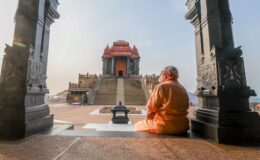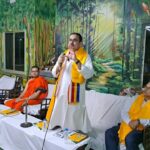FOR THEM, VIOLENCE AND KILLING IS LEGITIMATE
- By : Anirban Ganguly
- Category : Articles

Mamata’s neo-Razakars
The Trinamool Congress’s menacing brigade is on a marauding rampage in West Bengal
West Bengal, under Trinamool Congress rule directed by Mamata Banerjee, is facing a series of challenges that is fast posing a serious threat to its very democratic structure and future. In fact, under Banerjee, the ruling dispensation in the State and its voices and representatives in the national capital are increasingly seen to be representing a political formation, whose leaders across the levels, seem to have no sense of correctness and propriety when it comes to adhering to the rules of governance and to constitutionalism.
This disdain for the political process was seen in full display when Trinamool Congress Rajya Sabha member and Banerjee’s confidant Derek O’Brien, named a private citizen on the floor of the House, falsely accusing him of issuing threats and of using pejorative language on Twitter; when Trinamool MPs trooped together, collectively yelled and heckled Swapan Dasgupta, nominated member of the Upper House and a prominent Bengali himself, and prevented him from raising the issue of the Tehatta High School Saraswati Puja and when Mamata’s hoodlums in Hooghly attacked and badly beat up as veteran a leader of BJP in Bengal as Krishna Bhattacharya, who has been active with the party since the Bharatiya Jana Sangh days.
Mamata’s menacing brigade is on a marauding rampage. While her leaders and acolytes make a mockery of parliamentary procedures, Mamata’s administration, her party cadres, her captive mullahs, her police and her patronised intellectuals are all working overtime to change the dynamics of Bengal in a manner which has put the very raison d’être of the State under severe stress. The matriarch of course exclaims each time, “Kicchu hoyeni” — nothing has happened, that these are conspiracies by her opponents, especially by the BJP!
Under her patronage and political direction a new breed of Razakars — the neo-Razakars — has stuck roots in the State and are gradually growing in numbers. In the Indian political context and in the political context of the subcontinent and of South Asia, the Razakars always evoke dreaded memories of mass massacres and of collaborationism. In the Indian context, post-independence, the Razakars were those who perpetrated mass violence on Hindus in the erstwhile princely state of Hyderabad under the direction from the Nizam and his coterie. The Razakars collaborated with communists groups in the region in opposing and in trying to subvert India’s independence.
The Razakars habitually seek external intervention and collaborate with forces that are inimical to or are pledged to break apart the country from which the Razakars themselves operate. In the case of Hyderabad, the Razakars collaborated with the colonial Portuguese administration of Goa, aiding it in gunrunning and in terrifying satyagrahis pledged to Goa’s liberation.
In the south Asian context, the Razakars were those radical and Islamists elements in East Pakistan, who opposed the Bangladesh liberation war, collaborated with the genocidal Pakistan Army in massacring Bangladeshi intellectuals, Bengali Hindus and laboured to erase the ideals of the liberation war. Post 1971, the Razakars continued their manoeuvring with orders from Pakistan, strengthened the Jamaat in Bangladesh, advocated greater radicalisation of Bangladeshi society — in short, worked to subvert the experiment of a free, democratic and progressive Bangladesh from within.
Mamata’s neo-Razakars are a mélange of both these specimens. They revel and excel in terrorising the Hindus of West Bengal, in cleansing their villages, in occupying them. They habitually outshout, heckle, intimidate, attack and bully their political opponents or even those who hold opposite intellectual views.
Razakars are also distinguished by their contempt for intellectuals — the Nizam’s and those of East Pakistan exuded this hatred. Mamata’s neo-Razakars also display a condescension and contempt for intellectuals they cannot tame or for those who expose and oppose them. They also dabble into and are active in tasks that are patently anti-national and could compromise India’s national security — Khagragarh and Kalichak are but some the expressions of that nefariousness.
The neo-Razakars, like their historical counterparts, are also adept at raising resources through illegal means or through plain simple cheating. Rose Valley, Saradha, Narada, and the devastating trail of death and deprivation they have left behind actually reveal how Mamata’s neo-Razakars raised funds to support their politics of division and of violence.
The other defining characteristics of the Razakars are their collaborationist propensities with the mullahsand Islamists. Like the Razakars of the Nizam and of East Pakistan, Mamata’s own homegrown ones have woven an intricate and close-knit network with radical mullahs of the State. The tie-up with the notorious and regressive Imam Barkati is but one such association.
The Dhulagarh pogroms in December last, where Mamata’s hordes shouted and threatened Bengali Hindus of the area — mostly belonging to the Scheduled Caste communities — chanted “Pakistan zindabad!” and “Hindus leave West Bengal”, burnt their shops and gutted their homes; and the more recent attempt to prevent the children of the Tehatta High school in Nadia from celebrating Saraswati Puja, are clear indications that under Mamata Banerjee, the Bengali Hindus, perhaps for the first time since 1947, are facing a severe curtailment of their rights — religious, democratic, constitutional and threat to their very existence as it were.
The rise of Mamata’s neo-Razakars poses an acute existential challenge to the very vision of West Bengal.

















